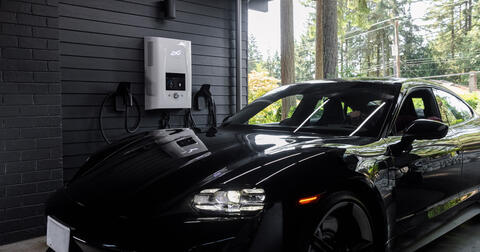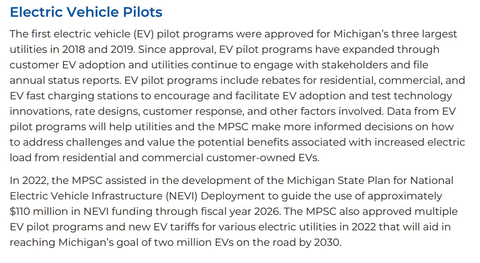Commentary
Winners and losers, carrots and sticks: The parable of the EV
Every time government picks the electric vehicle as a winner, the public loses

The EV is government’s favored vehicle. | Photo by
dcbel on Pexels
When we say the government should not pick winners and losers, what does that mean? Consider the parable of the electric vehicle vs the gas-powered vehicle.
All the gas engine has done, for more than a century, is power the modern world.
If it did not exist, it would have to be invented.
Perhaps the day will come when the electric vehicle is ready to unseat it. The pioneers of energy delivery and the auto industry, Thomas Edison and Henry Ford, took their best shot at the electric vehicle battery more than a century ago. And they failed.
A century later, range anxiety is still a problem in the EV market. Would-be buyers worry that they can’t go far due to a limited battery range and a lack of charging resources. Many EV batteries can’t survive a scratch. The battery is still the EV’s Achilles Heel.
Sen. Debbie Stabenow’s tale last year, of driving from Lansing to Washington, D.C. in her EV, without a worry about gas prices, was fictitious. EVs still need to be charged, and those charges take time. As my colleague Jamie Hope found, a drive of that length would have required at least two charge-ups, which would take a half-hour each.
That eight-hour drive from Michigan to D.C. would take an additional hour, just to recharge.
Nor is EV charging free. To buy an EV is not to replace the gas station with nothing.
It’s replacing the gas station with higher home energy bills. It’s mapping out charging resources, and a schedule for using them, before getting on the road.
Governments across America, from Lansing to Washington and many a state capital in between, are subsidizing EV charging stations. The feds say they want to create a nationwide network. It would be a good idea, if they weren’t using taxpayer money to do it.
The feds will give Michigan $110 million, in installments, between now and fiscal year 2026. It will buy only 127 EV chargers.
On the state side, Gov. Gretchen Whitmer has sought $2,000 rebates for EV buyers. In her 2024 budget, Whitmer requested $65 million to build charging stations and $48 million in sales and use tax exemptions for EV buyers over two years. When DTE moved to peak-hour billing in March, it excluded EVs.
It was the Michigan Public Service Commission that directed DTE to make peak-hour billing mandatory. The three-member board is appointed by the governor, and it was enlisted in her multi-department effort to get 2 million EVs on the road by 2030.

Two million is more EVs than were registered in all of America in 2021 (1.45 million), when Michigan had a mere 17,500 EVs registered.
If the charging resources weren’t enough, President Joe Biden pushed for and got $7,500 tax credits for most EV purchases, subsidizing the EV market. That’s the feds using the carrot to juice demand for EVs.
 Shutterstock
Shutterstock
The feds holding the sticks are regulators, who look to push the gas engine out of existence. According to The New York Times, the Biden administration looks to phase out new sales of gas engines “as soon as 2035.”
That’s the same year the European Union wants to stop allowing gas engine sales. It’s the same year Michigan will retire its last coal plant.
In 2036, the world will be a different place. Haven’t heard anyone say it will be better.
Let’s see if the EV can succeed on its own merits.
Remove any leg from the stool — the charger subsidies, the buyer subsidies, or the regulator pressure — and the EV would occupy a place similar to self-driving cars: Another bright idea that’s not ready for prime time.
James David Dickson is managing editor of Michigan Capitol Confidential. Email him at dickson@mackinac.org.
|

Winners and losers, carrots and sticks: The parable of the EV
Every time government picks the electric vehicle as a winner, the public loses
When we say the government should not pick winners and losers, what does that mean? Consider the parable of the electric vehicle vs the gas-powered vehicle.
All the gas engine has done, for more than a century, is power the modern world.
If it did not exist, it would have to be invented.
Perhaps the day will come when the electric vehicle is ready to unseat it. The pioneers of energy delivery and the auto industry, Thomas Edison and Henry Ford, took their best shot at the electric vehicle battery more than a century ago. And they failed.
A century later, range anxiety is still a problem in the EV market. Would-be buyers worry that they can’t go far due to a limited battery range and a lack of charging resources. Many EV batteries can’t survive a scratch. The battery is still the EV’s Achilles Heel.
Sen. Debbie Stabenow’s tale last year, of driving from Lansing to Washington, D.C. in her EV, without a worry about gas prices, was fictitious. EVs still need to be charged, and those charges take time. As my colleague Jamie Hope found, a drive of that length would have required at least two charge-ups, which would take a half-hour each.
That eight-hour drive from Michigan to D.C. would take an additional hour, just to recharge.
Nor is EV charging free. To buy an EV is not to replace the gas station with nothing.
It’s replacing the gas station with higher home energy bills. It’s mapping out charging resources, and a schedule for using them, before getting on the road.
Governments across America, from Lansing to Washington and many a state capital in between, are subsidizing EV charging stations. The feds say they want to create a nationwide network. It would be a good idea, if they weren’t using taxpayer money to do it.
The feds will give Michigan $110 million, in installments, between now and fiscal year 2026. It will buy only 127 EV chargers.
On the state side, Gov. Gretchen Whitmer has sought $2,000 rebates for EV buyers. In her 2024 budget, Whitmer requested $65 million to build charging stations and $48 million in sales and use tax exemptions for EV buyers over two years. When DTE moved to peak-hour billing in March, it excluded EVs.
It was the Michigan Public Service Commission that directed DTE to make peak-hour billing mandatory. The three-member board is appointed by the governor, and it was enlisted in her multi-department effort to get 2 million EVs on the road by 2030.
Two million is more EVs than were registered in all of America in 2021 (1.45 million), when Michigan had a mere 17,500 EVs registered.
If the charging resources weren’t enough, President Joe Biden pushed for and got $7,500 tax credits for most EV purchases, subsidizing the EV market. That’s the feds using the carrot to juice demand for EVs.
The feds holding the sticks are regulators, who look to push the gas engine out of existence. According to The New York Times, the Biden administration looks to phase out new sales of gas engines “as soon as 2035.”
That’s the same year the European Union wants to stop allowing gas engine sales. It’s the same year Michigan will retire its last coal plant.
In 2036, the world will be a different place. Haven’t heard anyone say it will be better.
Let’s see if the EV can succeed on its own merits.
Remove any leg from the stool — the charger subsidies, the buyer subsidies, or the regulator pressure — and the EV would occupy a place similar to self-driving cars: Another bright idea that’s not ready for prime time.
James David Dickson is managing editor of Michigan Capitol Confidential. Email him at dickson@mackinac.org.
Michigan Capitol Confidential is the news source produced by the Mackinac Center for Public Policy. Michigan Capitol Confidential reports with a free-market news perspective.
More From CapCon